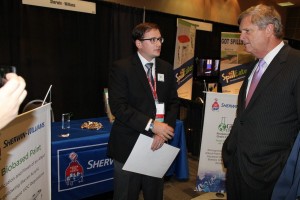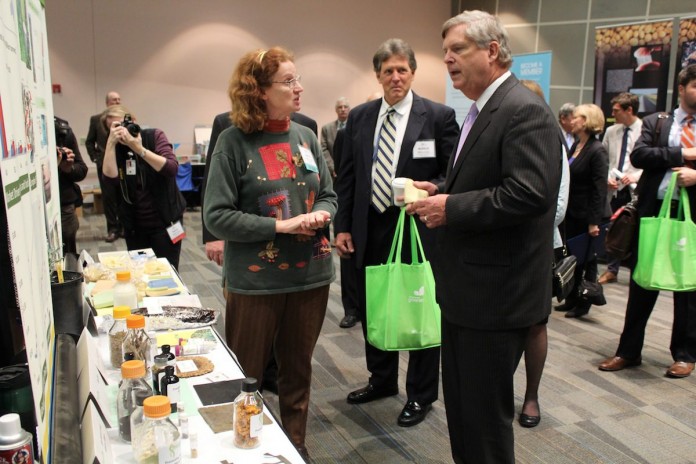COLUMBUS — Long before he made his way to the podium at the Bioproducts World Showcase Oct. 7, in Columbus, U.S. Secretary of Agriculture Tom Vilsack was already in close conversation with most of the companies and researchers who attended the inaugural event.
Vilsack and his federal staffers visited each booth at the show — observing such things as bio-based paint, construction material, packaging and shipping material, food service supplies, cleaning supplies and automobile supplies — all made in part from plant and agricultural products.
Many products
So far, the U.S. Department of Agriculture has certified nearly 2,000 biobased products, and many more applications are pending. The secretary shared his enthusiasm for what those products can do for the world economy, and for agriculture.
“It’s a new economy, it’s a new way of doing business and it’s an exciting opportunity,” he said.

What the bioproducts industry does, he said, is “complement” and support production agriculture, as well as the manufacturing industry. This means more innovation and research, more demand for farm products and more opportunity for job growth.
“I think it (bioproducts) is very much a complement to agriculture generally, and production agriculture specifically,” he said. “I think it creates potential manufacturing jobs and bioprocessing jobs in rural communities.”
More than yield
Earlier in the day, at a luncheon, Ohio soybean grower and United Soybean member Dan Corcoran, of Piketon, said how years ago his main concern as a farmer was yield.
Turns out, he’s still concerned about yield — but much more.
“I no-longer just see yield,” he said. “I see oil, I see foam, I see plastics. I see lots of opportunities for us to grow together.”
The Bioproducts World Showcase was organized and directed by Ohio State University’s Bioproducts Innovation Center (OBIC), along with partners like USDA, United Soybean Board and the Ohio Soybean Council.
The goal of OBIC is to “help all of you get to the marketplace” and to help span the “agriculture side” of bioproducts, with “the retail side,” said Max Maksimoski, industrial liaison for OBIC.
Dennis Hall, OBIC director, said about 42 venders displayed products this year, and he expects even more interest in the second year. In addition to the products already being showcased, he predicted there would be even more products “emerging” from the collaboration among people at the show.
He said there are so many biobased products in the markteplace that people often don’t recognize them all. They’re in paints and coatings, lubricants, food service items — even things like new John Deere combines — which Hall said use a biobased composite panel.
Securing the funds
One of the industry’s challenges, Hall said, is getting investors and banks to finance bioproducts. However, this is slowly being overcome, he said, with more banks seeing the opportunities, and with improvements to the 2014 farm bill, which now provides guaranteed loans and financial support for the biobased products industry.
Vilsack reminded the crowd of USDA’s various commitments to the biobased industry, including the USDA BioPreferred program, which certifies biobased products according to the contents, and helps promote the biobased industry.
Federal agencies like USDA are required to purchase certain percentages of biobased products, which are usually considered as good or better than the non-biobased counterparts. The USDA also offers a voluntary “Certified Biobased Product” label, to help promote those products.
The same day as the conference, USDA released a report called “Why Biobased?”, which shows that biobased chemicals are expected to make up more than 10 percent of the chemical market by 2015.
And, there is produce two-thirds of the total volume of chemicals from biobased materials, representing more than 50,000 products, according to another report in the study.
While the bioproducts industry relies on commodity crops like corn and soybeans, it also uses plants such as switchgrass, miscanthus, and woody, tree-based products.
What about competition
Some bioproducts, especially biofuels such as ethanol, have occasionally been criticized for competing with livestock feed and consumer food.
But Vilsack said he doesn’t see competition from today’s bioproducts, partly because the bioproducts industry is heavily reliant on waste materials and things that don’t typically go into the food supply to begin with.
Instead, he said bioproducts are a way of creating “alternative market opportunities,” especially for small and mid-size farm operations, “so they can stay in business and stay on the farm.”
Hall said he supports ethanol, but a big difference between ethanol and other biobased products is the amount of feedstuff required. Ethanol consumes much more, while bioproducts take much less.
“Biopased products is a very different ball game than transportation fuels,” Hall said.










